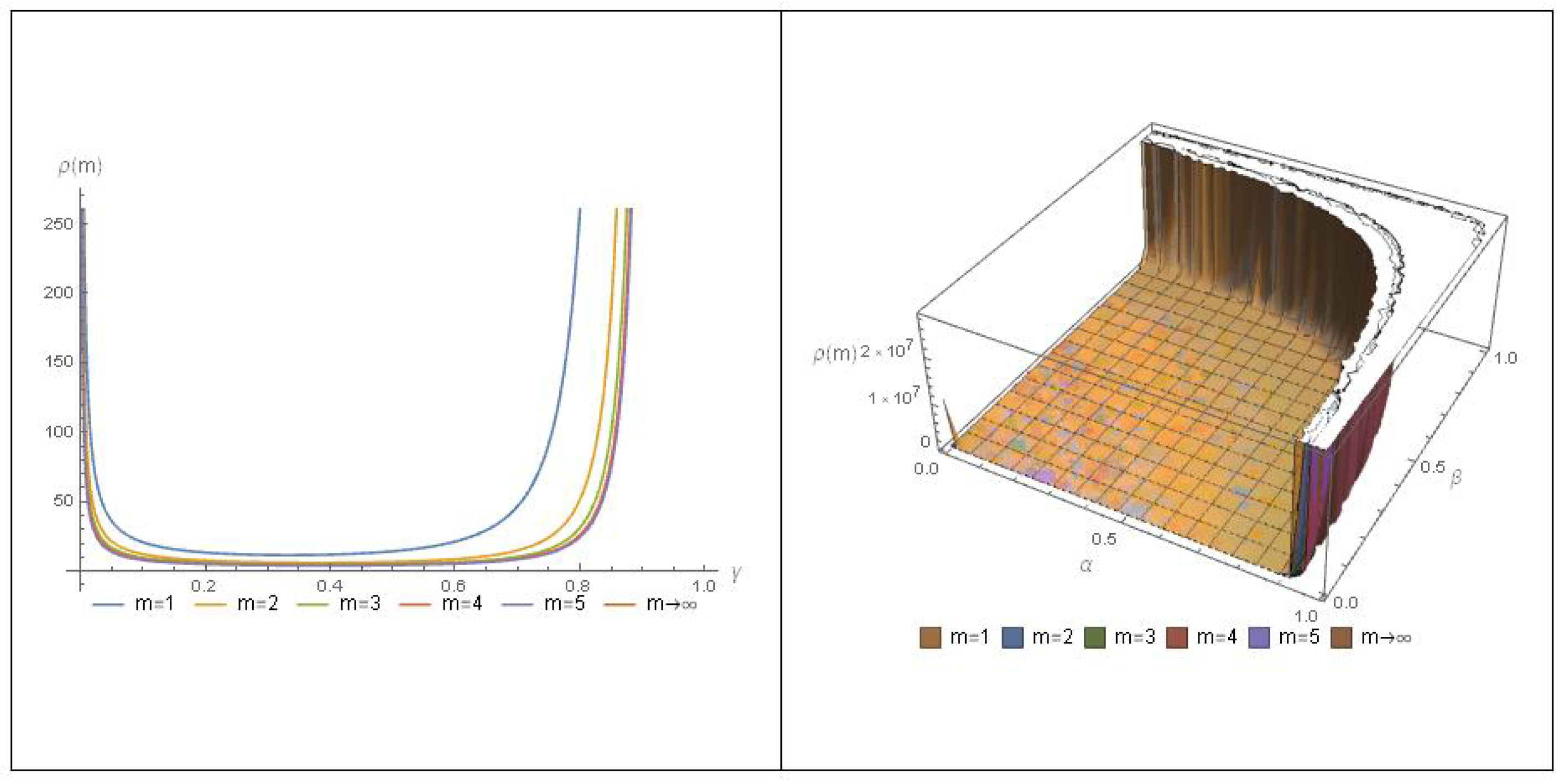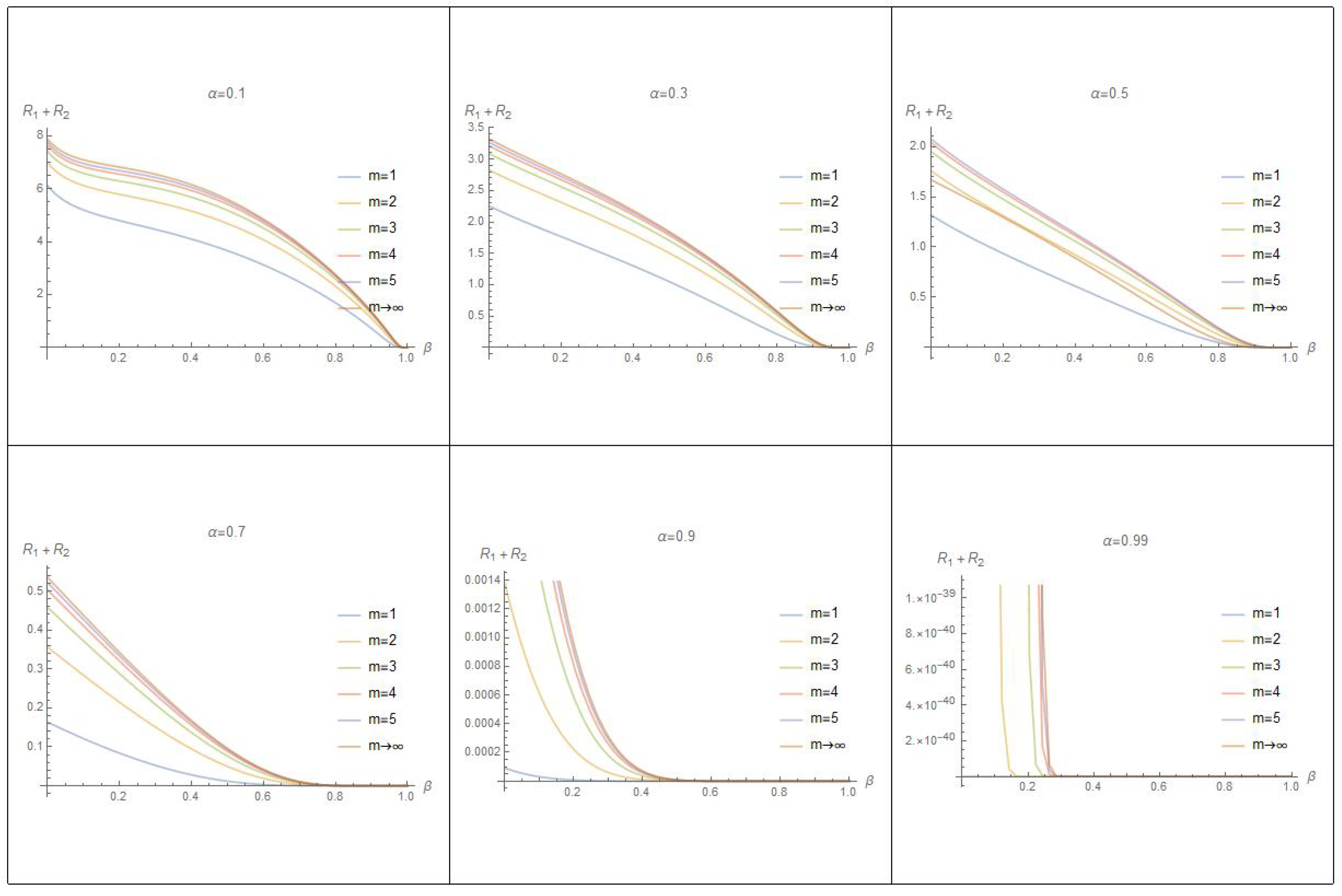Fractional Evolution Equation with Nonlocal Multi-Point Condition: Application to Fractional Ginzburg–Landau Equation
Abstract
1. Introduction
- : The state function in Banach space equipped with the norm ;
- : A Hilfer–Katugampola fractional derivative of order and types and ;
- : A Katugampola fractional integral of order with ;
- A: An infinitesimal generator of semigroup in a Banach space ;
- : The continuous function in a Banach space ;
- are real constants;
- are positive real constants such that .
2. Preliminaries
2.1. Fractional Calculus
- The infinite series is called the Neumann series, and it is also an element in .
- The operator has a bounded inverse operator on .
- .
- (Eigenvalue) There is a non-trivial solution to the equation .
- (Bounded resolvent) The operator has a bounded inverse on .
- u and v are nonnegative;
- g is nonnegative and nondecreasing.
2.2. -Laplace Transform
2.3. Semigroup
- where (the semigroup property);
- , where I is the identity operator in .
3. Construct of Mild Solution and Some Properties
- 1.
- For any fixed , the operators and are linear and satisfyfor all ;
- 2.
- The operators and are strongly continuous for all ;
- 3.
- If is a compact set, then the operators and are also compact operators for every .
- 1.
- The linearity of the semi group operator Q implies the linearity of and . Assume that H1 is satisfied. If letting in the Definition 9. Direct calculating gives:From the Definition 1, Lemma 1 and inequality (8), we have
- 2.
- Let for all and , whereHence, for any and , we obtainHere, we use the well-know formula for all and . Under the assumption H1 and based on Lebesgue dominated convergence Theorem 1, we see that approaches zero as . Now, since and , then which implies thatConsequently, we havewhich means that the operator is strongly continuous for all . Similarly, we havewhere is the incomplete Beta function for . It is known that . Consequently, we havewhich means that the operator is strongly continuous for all .
- 3.
- Define . It is clear that is a closed and bounded subset in .Now, we need to prove the relative compactness of the two sets and in , where
4. Construct of Mild Solution with Multi-Point Conditions
- C1:
- There exist some real numbers such that
- C2:
- The operator is compact for each and the homogeneous linear nonlocal problemhas no non-trivial mild solutions.
5. Existence and Uniqueness of Mild Solution
- (I)
- The function ;
- (II)
- There exists a positive constant such thatfor all .
6. An Application: The Real Ginzburg–Landau Equation
7. Conclusions
Author Contributions
Funding
Data Availability Statement
Conflicts of Interest
References
- Oliver, C. Evolution Equations in Scales of Banach Spaces; TEUBNER-TEXTE zur Mathematik; Springer: Berlin/Heidelberg, Germany, 2002. [Google Scholar]
- Cazenave, T.; Haraux, A.; Martel, Y. An Introduction to Semilinear Evolution Equations; Clarendon Press: Oxford, UK, 1999. [Google Scholar]
- Salem, A.; Alharbi, K.N. Controllability for fractional evolution equations with infinite time-delay and non-local conditions in compact and noncompact cases. Axioms 2023, 12, 264. [Google Scholar] [CrossRef]
- Baghani, H.; Salem, A. Solvability and stability of a class of fractional Langevin differential equations. Boletín Soc. Mat. Mex. 2024, 30, 46. [Google Scholar] [CrossRef]
- Zhou, Y. Basic Theory of Fractional Differential Equations; World Scientific: Singapore, 2014. [Google Scholar]
- Salem, A.; Alharbi, K.N. Fractional infinite time-delay evolution equations with non-instantaneous impulsive. AIMS Math. 2023, 8, 12943–12963. [Google Scholar] [CrossRef]
- Salem, A. Existence results of solutions for anti-periodic fractional Langevin equation. J. Appl. Anal. Comput. 2020, 10, 2557–2574. [Google Scholar] [CrossRef] [PubMed]
- Zhou, Y.; Jiao, F. Existence of mild solutions for fractional neutral evolution equations. Comput. Math. Appl. 2010, 59, 1063–1077. [Google Scholar] [CrossRef]
- Norouzi, F.; N’guérékata, G.M. Existence results to a ψ-Hilfer neutral fractional evolution equation with infinite delay. Nonautonomous Dyn. Syst. 2021, 8, 101–124. [Google Scholar] [CrossRef]
- Suechoei, A.; Ngiamsunthorn, P. Existence uniqueness and stability of mild solutions for semilinear ψ-Caputo fractional evolution equations. Adv. Differ. Equ. 2020, 114, 1–28. [Google Scholar] [CrossRef]
- Salem, A.; Alharbi, K.; Alshehri, H. Fractional Evolution Equations with Infinite Time Delay in Abstract Phase Space. Mathematics 2022, 10, 1332. [Google Scholar] [CrossRef]
- Salem, A.; Alharbi, K.N. Total Controllability for a Class of Fractional Hybrid Neutral Evolution Equations with Non-Instantaneous Impulses. Fractal Fract. 2023, 7, 423. [Google Scholar] [CrossRef]
- Byszewski, L. Theorems about the existence and uniqueness of a semilinar evolution nonlocal Cauchy problem. Math. Anal. Appl. 1991, 162, 494–495. [Google Scholar] [CrossRef]
- Tariboon, J.; Samadi, A.; Ntouyas, S.K. Multi-Point Boundary Value Problems for (k, ϕ)-Hilfer Fractional Differential Equations and Inclusions. Axioms 2022, 11, 110. [Google Scholar] [CrossRef]
- Sevinik-Adigüzel, R.; Aksoy, Ü.; Karapinar, E.; Erhan, I.M. Uniqueness of solution for higher-order nonlinear fractional differential equations with multi-point and integral boundary conditions. Rev. Real Acad. Cienc. Exactas Fís. Nat. Ser. A Mat. 2021, 115, 155. [Google Scholar] [CrossRef]
- Luca, R. Positive Solutions for a System of Fractional q-Difference Equations with Multi-Point Boundary Conditions. Fractal Fract. 2024, 8, 70. [Google Scholar] [CrossRef]
- Salem, A.; Alghamdi, B. Multi-strip and multi-point boundary conditions for fractional Langevin equation. Fractal Fract. 2020, 4, 18. [Google Scholar] [CrossRef]
- Salem, A.; Alghamdi, B. Multi-Point and Anti-Periodic Conditions for Generalized Langevin Equation with Two Fractional Orders. Fractal Fract. 2019, 3, 51. [Google Scholar] [CrossRef]
- Salem, A.; Alzahrani, F.; Alnegga, M. Coupled system of nonlinear fractional Langevin equations with multi-point and nonlocal integral boundary conditions. Math. Probl. Eng. 2020, 2020, 7345658. [Google Scholar] [CrossRef]
- Almaghamsi, L.; Salem, A. Fractional Langevin equations with infinite-point boundary condition: Application to Fractional harmonic oscillator. J. Appl. Anal. Comput. 2023, 13, 3504–3523. [Google Scholar] [CrossRef]
- Deng, K. Exponential Decay of Solutions of Semilinear Parabolic Equations with Nonlocal Initial Conditions. J. Math. Anal. Appl. 1993, 179, 630–637. [Google Scholar] [CrossRef]
- Ginzburg, V.L.; Landau, L.D. On the Theory of Superconductivity. Zhurnal Eksperimental’noi Teor. Fiz. 1950, 20, 1064–1082. [Google Scholar]
- Newell, A.C.; Whitehead, J.A. Finite bandwidth, finite amplitude convection. J. Fluid Mech. 1969, 38, 279–303. [Google Scholar] [CrossRef]
- Segel, A.L. Distant side-walls cause slow amplitude modulation of cellular convection. J. Fluid Mech. 1969, 38, 203–224. [Google Scholar] [CrossRef]
- Raza, N. Exact periodic and explicit solutions of the conformable time fractional Ginzburg Landau equation. Opt. Quant. Electron. 2018, 50, 154. [Google Scholar] [CrossRef]
- Akram, G.; Arshed, S.; Sadaf, M.; Farooq, K. A study of variation in dynamical behavior of fractional complex Ginzburg-Landau model for different fractional operators. Ain Shams Eng. J. 2023, 14, 102120. [Google Scholar] [CrossRef]
- Murad, M.A.S.; Ismael, H.F.; Hamasalh, F.K.; Shah, N.A.; Eldin, S.M. Optical soliton solutions for time-fractional Ginzburg-Landau equation by a modified sub-equation method. Results Phys. 2023, 53, 106950. [Google Scholar] [CrossRef]
- Zhou, Y. Fractional Evolution Equations and Inclusions; Academic Press: Cambridge, MA, USA, 2016. [Google Scholar]
- Jiménez, V.M.; de León, M. The evolution equation: An application of groupoids to material evolution. J. Geom. Mech. 2022, 14, 331–348. [Google Scholar] [CrossRef]
- Salem, A.; Abdullah, S. Controllability results to non-instantaneous impulsive with infinite delay for generalized fractional differential equations. Alex. Eng. J. 2023, 70, 525–533. [Google Scholar] [CrossRef]
- Jarad, F.; Abdeljawad, T. A modified Laplace transform for certain generalized fractional operators. Results Nonlinear Anal. 2018, 1, 88–98. [Google Scholar]
- Katugampola, U. New approach to a generalized fractional integral. Appl. Math. Comput. 2011, 218, 860–865. [Google Scholar] [CrossRef]
- Katugampola, U. New approach to a generalized fractional derivatives. Bull. Math. Anal. Appl. 2014, 6, 1–15. [Google Scholar]
- Oliveira, D.; de Oliveira, E.C. Hilfer-Katugampola fractional derivatives. Comp. Appl. Math. 2018, 37, 3672–3690. [Google Scholar] [CrossRef]
- Hong, D.; Wang, J.; Gardner, R. Real Analysis with an Introduction to Wavelets; Elsevier Inc.: London, UK, 2005. [Google Scholar]
- Lundsgaard, H.V. Functional Analysis Entering Hilbert Space, 2nd ed.; World Scientific: Singapore, 2006. [Google Scholar]
- Almeida, R. A Gronwall inequality for a general Caputo fractional operator. Math. Inequalities Appl. 2017, 20, 1089–1105. [Google Scholar] [CrossRef]
- Abdeljawad, T. On conformable fractional calculus. J. Compubtational Appl. Math. 2013, 279, 57–66. [Google Scholar] [CrossRef]
- Pazy, A. Semigroups of Linear Operators and Applications to Partial Differential Equations, 1st ed.; Springer New York Inc.: New York, NY, USA, 1983. [Google Scholar]




Disclaimer/Publisher’s Note: The statements, opinions and data contained in all publications are solely those of the individual author(s) and contributor(s) and not of MDPI and/or the editor(s). MDPI and/or the editor(s) disclaim responsibility for any injury to people or property resulting from any ideas, methods, instructions or products referred to in the content. |
© 2025 by the authors. Licensee MDPI, Basel, Switzerland. This article is an open access article distributed under the terms and conditions of the Creative Commons Attribution (CC BY) license (https://creativecommons.org/licenses/by/4.0/).
Share and Cite
Salem, A.; Al-Maalwi, R. Fractional Evolution Equation with Nonlocal Multi-Point Condition: Application to Fractional Ginzburg–Landau Equation. Axioms 2025, 14, 205. https://doi.org/10.3390/axioms14030205
Salem A, Al-Maalwi R. Fractional Evolution Equation with Nonlocal Multi-Point Condition: Application to Fractional Ginzburg–Landau Equation. Axioms. 2025; 14(3):205. https://doi.org/10.3390/axioms14030205
Chicago/Turabian StyleSalem, Ahmed, and Rania Al-Maalwi. 2025. "Fractional Evolution Equation with Nonlocal Multi-Point Condition: Application to Fractional Ginzburg–Landau Equation" Axioms 14, no. 3: 205. https://doi.org/10.3390/axioms14030205
APA StyleSalem, A., & Al-Maalwi, R. (2025). Fractional Evolution Equation with Nonlocal Multi-Point Condition: Application to Fractional Ginzburg–Landau Equation. Axioms, 14(3), 205. https://doi.org/10.3390/axioms14030205





